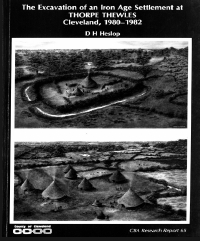CBA Research Reports
Council for British Archaeology, 2000. (updated 2020) https://doi.org/10.5284/1000332. How to cite using this DOI
Data copyright © Council for British Archaeology unless otherwise stated
This work is licensed under the ADS Terms of Use and Access.
Primary contact
Council for British Archaeology
92 Micklegate
York
YO1 6JX
UK
Tel: 01904 671417
Resource identifiers
- ADS Collection: 281
- DOI:https://doi.org/10.5284/1000332
- How to cite using this DOI
The Excavation of an Iron Age Settlement at Thorpe Thewles, Cleveland, 1980-1982
D H Heslop
CBA Research Report No 65 (1987)
ISBN 0 906780 65 9
Abstract

Excavation on the site of a cropmark enclosure revealed a complex sequence of occupation stretching from the Mid Iron Age to the 1st century AD with evidence of landscape organization before and after this period. The site produced the largest collections of Iron Age finds, animal remains and carbonized seeds recovered from northern England to date, and a wide range of structures, enclosures and boundaries were recorded. The results point to an unsuspected level of development in the fertile lowlands of the region. They suggest that this part of northern England at least was participating in social, economic and agricultural developments normally associated with southern England, including the early introduction of rotary querns and spelt and the adoption of complex, nucleated settlement types.
Contents
- Title pages
- Contents (p v)
- Illustrations (pp vi-vii)
- Tables (p viii)
- Acknowledgements (p ix)
- I Introduction (pp 1-6)
- Summary (p 1)
- Background information (p 1)
- Geology and soils (p 1)
- Medieval and later land use (p 1)
- Aerial photography (p 1)
- Pre-excavation survey (p 5)
- II Excavation description (pp 7-56)
- Introduction (p 7)
- Recording and numbering (pp 7-9)
- Site phasing (p 9)
- Phase I (p 9)
- Phase II (pp 9-15)
- The central house (pp 15-28)
- Other circular structures (p 29)
- Enclosure partitions (pp 29-34)
- The main house - abandonment (pp 34-36)
- Phase III (pp 36-51)
- Phase IV (p 51)
- Unphased (pp 51-52)
- Index of microfiche report (pp 53-56)
- III The finds (pp 57-109)
- Introduction (p 57)
- The Iron Age pottery by H P Swain (pp 57-71)
- The thermoluminescent dating of the Iron Age pottery by I K Bailiff (pp 71-72)
- The Romano-British pottery by M Millett (pp 73-75)
- The Mortaria by K F Hartley (pp 75-76)
- Objects of fired clay by H P Swain (p 76)
- Metalwork by Lindsey Allason-Jones (pp 77-82)
- Objects of glass by Jennifer Price (pp 82-84)
- Querns by D H Heslop (pp 84-89)
- Other objects of stone by H P Swain and D H Heslop (p 89)
- Objects of worked bone and antler by H P Swain (pp 89-92)
- The metalworking debris by J G Mcdonell (p 92)
- Non-ferrous metalworking by D H Heslop (p 92)
- The plant remains by M Van der Veen (pp 93-99)
- The animal bone by D James Rackham (pp 99-109)
- IV Discussion (pp 110-119)
- The chronology of the site (pp 110-111)
- The chronology of the finds (p 111)
- Environment and location of the settlement (pp 111-113)
- Structure and use of the enclosure (pp 113-119)
- Economic basis of the settlement (pp 119-120)
- Bibliography (pp 121-124)
- Plates 1-11
- Site plan
- V Microfiche supplement
- Contexts
- Finds
Download report
| The Excavation of an Iron Age Settlement at Thorpe Thewles, Cleveland, 1980-1982 (CBA Research Report 65) | 7 Mb | |
| The Excavation of an Iron Age Settlement at Thorpe Thewles, Cleveland, 1980-1982 (microfiche) | 17 Mb |







